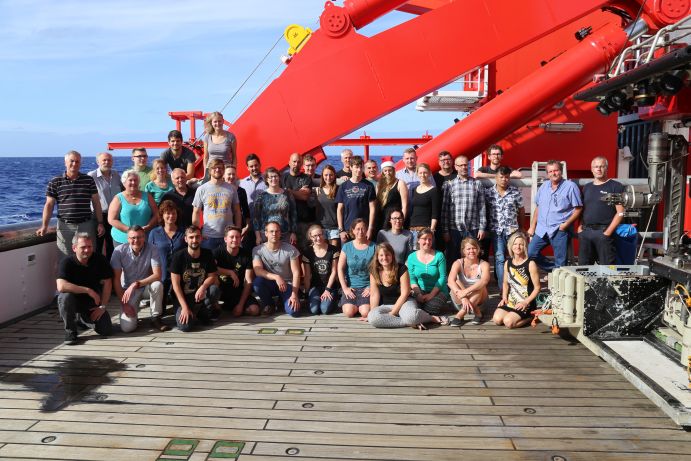New expedition movie documents research trip to the hot spings off New Zealand
The expedition SO253 takes the RV SONNE into the middle of the collision zone of two large tectonic plates. Here, the Pacific plate subducts under the Australian continental plate. At this intersection of the plates, a chain of volcanoes formed many millions of years ago, forming the Kermadec volcanic arc between New Zealand and Tonga. Only four of the more than 30 larger volcanoes stick out of the water, forming the Kermadec islands: Raoul Island, Macauley Island, Curtis Island, and Nugent Island. The SONNE expedition, however, will dedicate its activities to the underwater volcanoes Macauley Cone, Haungaroa, Brothers, and Rumble III. In the Kermadec arc, volcanic eruptions are frequent even in the present day. The goal of the expedition is to investigate hydrothermal vents discharging at the submarine volcanoes. The scientists want to find out what influence the vents have on the seawater and on life in the vicinity of the hydrothermally active systems.
On 22 December 2016, the most modern German research vessel, the “Sonne” (“sun”), sets out from the port of Nouméa in New Caledonia. On board are 40 scientists and a crew of 31. Their destination is the Kermadec volcanic arc off the coast of New Zealand. The QUEST underwater robot dives down to four submarine volcanoes and transmits videos of the ocean floor back to the ship in real time. At the submarine volcanoes the scientists come across hot springs: the sea here teems with organisms, and hot fluids and dissolved copper and iron bubble up through pillar-shaped chimneys into the seawater. The researchers are interested in the exchange processes associated with these springs and in the animals and bacteria that live here.
Video: Research Cruise SO253 of RV SONNE
“I warmly invite you to take a tour of the newest and most up-to-date research vessel in the German research fleet. The vessel was built in Papenburg and has been in use as a research platform for science in the Indian and Pacific Oceans since November 2014, says Captain Lutz Mallon.
Cruise leader Prof. Dr. Andrea Koschinsky: “My name is Andrea Koschinsky. I am a marine geochemist at Jacobs University in Bremen; I am a professor and researcher there and right now I am here on board the Sonne as cruise leader of research expedition SO253. I have been to sea many times. What I always like is the community that forms here straight away. We depend on each other and fantastic communities form; people give each other incredible support and of course I am also responsible for ensuring that we communicate well with the crew and that we discuss everything properly. That means that we have regular meetings with representatives of the ship’s crew.”
“It’s about a lot of general processes that we want to understand, such as the workings of the material cycles in the oceans that influence the climate and our resources. We consider hydrothermal systems from all sorts of angles and what I really enjoy is seeing how the results of all these individual areas of study help us piece together a giant jigsaw of the regions here. I have looked forward to this all along and it is working in exactly the way that I imagined.”
Prof. Dr. Harald Strauss explains: “We cut through this chimney lengthwise so that we could look inside. What we see in the main is four minerals. In these chimneys we have on the one hand the hot fluid that comes up from below through the pipe. And then the whole structure is porous, so that a lot of seawater comes in from the side.”
Andrea Koschinsky summarizes: “We have discovered new hydrothermal systems; there are others from which we have been able to take samples and obtain data that no one has had before. So there have already been lots of highlights.”




